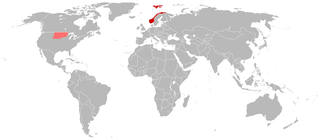
In physical geography, tundra is a type of biome where the tree growth is hindered by low temperatures and short growing seasons. The term tundra comes through Russian тундра from the Kildin Sami word тӯндар meaning "uplands", "treeless mountain tract". Tundra vegetation is composed of dwarf shrubs, sedges and grasses, mosses, and lichens. Scattered trees grow in some tundra regions. The ecotone between the tundra and the forest is known as the tree line or timberline.
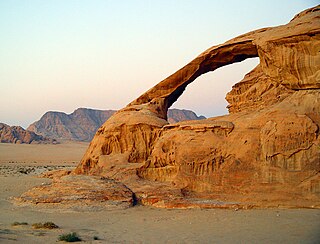
Weathering is the breaking down of rocks, soil, and minerals as well as wood and artificial materials through contact with the Earth's atmosphere, water, and biological organisms. Weathering occurs in situ, that is, in the same place, with little or no movement, and thus should not be confused with erosion, which involves the movement of rocks and minerals by agents such as water, ice, snow, wind, waves and gravity and then being transported and deposited in other locations.
The climate of the Alps is the climate, or average weather conditions over a long period of time, of the exact middle Alpine region of Europe. As air rises from sea level to the upper regions of the atmosphere the temperature decreases. The effect of mountain topography on prevailing winds is to force warm air from the lower region into an upper zone where it expands in volume at the cost of a proportionate loss of heat, often accompanied by the precipitation of moisture in the form of snow, rain or hail.

A fellfield or fell field comprises the environment of a slope, usually alpine or tundra, where the dynamics of frost and of wind give rise to characteristic plant forms in scree interstices.
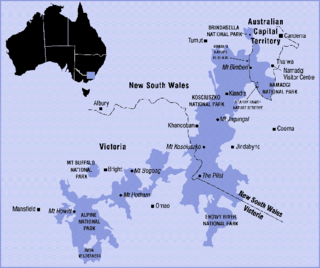
The Australian Alps montane grasslands is a montane grassland ecoregion of south-eastern Australia, restricted to the montane regions above 1300 metres.

The tree line is the edge of the habitat at which trees are capable of growing. It is found at high elevations and high latitudes. Beyond the tree line, trees cannot tolerate the environmental conditions. The tree line is sometimes distinguished from a lower timberline or forest line, which is the line below which trees form a forest with a closed canopy.

A subshrub or dwarf shrub is a short woody plant. Prostrate shrub is a related term. "Subshrub" is often used interchangeably with "bush".

In forestry, windthrow or blowdown refers to trees uprooted or broken by wind. Breakage of the tree bole (trunk) instead of uprooting is sometimes called windsnap.

Alpine plants are plants that grow in an alpine climate, which occurs at high elevation and above the tree line. There are many different plant species and taxon that grow as a plant community in these alpine tundra. These include perennial grasses, sedges, forbs, cushion plants, mosses, and lichens. Alpine plants are adapted to the harsh conditions of the alpine environment, which include low temperatures, dryness, ultraviolet radiation, and a short growing season.
Xerosere is a plant succession that is limited by water availability. It includes the different stages in a xerarch succession. Xerarch succession of ecological communities originated in extremely dry situation such as sand deserts, sand dunes, salt deserts, rock deserts etc. A xerosere may include lithoseres and psammoseres.
A lithosere is a plant succession that begins life on a newly exposed rock surface, such as one left bare as a result of glacial retreat, tectonic uplift as in the formation of a raised beach, or volcanic eruptions. For example, the lava fields of Eldgjá in Iceland where Laki and Katla fissures erupted in the year 935 and the solidified lava has, over time, begun to form a lithosere.

The Sierra Nevada subalpine zone refers to a biotic zone below treeline in the Sierra Nevada mountain range of California, United States. This subalpine zone is positioned between the upper montane zone at its lower limit, and tree line at its upper limit.
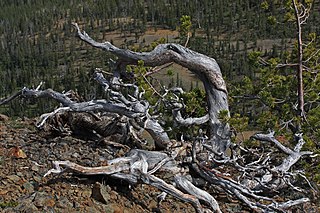
Krummholz or krumholtz — also called knieholz — is a type of stunted, deformed vegetation encountered in subarctic and subalpine tree line landscapes, shaped by continual exposure to fierce, freezing winds. Under these conditions, trees can only survive where they are sheltered by rock formations or snow cover. As the lower portion of these trees continues to grow, the coverage becomes extremely dense near the ground. In Newfoundland and Labrador, the formation is known as tuckamore. Krummholz trees are also found on beaches such as the Oregon coast, where trees can become much taller than their subalpine cousins.

A desert is a barren area of landscape where little precipitation occurs and, consequently, living conditions are hostile for plant and animal life. The lack of vegetation exposes the unprotected surface of the ground to the processes of denudation. About one-third of the land surface of the world is arid or semi-arid. This includes much of the polar regions where little precipitation occurs and which are sometimes called polar deserts or "cold deserts". Deserts can be classified by the amount of precipitation that falls, by the temperature that prevails, by the causes of desertification or by their geographical location.

Frost weathering is a collective term for several mechanical weathering processes induced by stresses created by the freezing of water into ice. The term serves as an umbrella term for a variety of processes such as frost shattering, frost wedging and cryofracturing. The process may act on a wide range of spatial and temporal scales, from minutes to years and from dislodging mineral grains to fracturing boulders. It is most pronounced in high-altitude and high-latitude areas and is especially associated with alpine, periglacial, subpolar maritime and polar climates, but may occur anywhere at sub-freezing temperatures if water is present.
Herbfields are plant communities dominated by herbaceous plants, especially forbs and grasses. They are found where climatic conditions do not allow large woody plants to grow, such as in subantarctic and alpine tundra environments. Herbfield is defined in New South Wales (Australia) government legislation as native vegetation that predominantly does not contain an over-storey or a mid-storey and where ground cover is dominated by non-grass species. The New Zealand Department of Conservation has described herbfield vegetation as that in which the cover of herbs in the canopy is 20–100%, and in which herb cover is greater than that of any other growth form, or of bare ground.
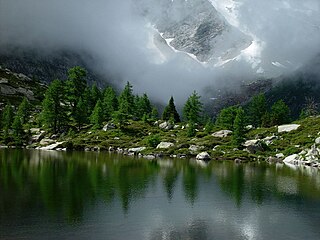
Montane ecosystems refers to any ecosystem found in mountains. These ecosystems are strongly affected by climate, which gets colder as elevation increases. They are stratified according to elevation. Dense forests are common at moderate elevations. However, as the elevation increases, the climate becomes harsher, and the plant community transitions to grasslands or tundra.
Alpine vegetation refers to the zone of vegetation between the altitudinal limit for tree growth and the nival zone. Alpine zones in Tasmania can be difficult to classify owing to Tasmania's maritime climate limiting snow lie to short periods and the presence of a tree line that is not clearly defined.

